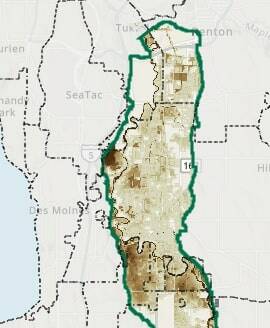Parts of Auburn, Kent, Renton, SeaTac, Tukwila and unincorporated King County could be swamped by more than a foot of water in a major flood, the King County Flood Control District announced April 30.
According to the district, the risk posed to the 21-mile corridor along the Lower Green River could affect more than 27,000 residents and the stability of 28,000 jobs.
Michelle Clark, executive director of the KCFCD, said April 30 that while the risk is real, “the big floods” under discussion haven’t been seen in the corridor since the construction of the Howard Hanson Dam in 1959 — he project that made the industrialization and commercial development of the valley possible, including the construction of Southcenter on what had been marsh.
“We’ve had some big rain events recently, but the Green River hasn’t left its banks, which is good,” Clark said.
The district has conducted a study of methods to manage the flood risk and released this study as a final Programmatic Environmental Impact Statement (PEIS) on April 30. The document evaluates three flood-hazard management alternatives that substantially reduce flooding across the corridor.
The PEIS analyzes impacts, benefits and costs of planning-level decisions that affect a large area. Benefits could include providing better habitat for salmon and additional recreation and open space along the river.
“We still have an obligation to fulfill the promise that the Army Corps of Engineers made — when they built the Howard Hanson Dam — and try to provide that level of protection people thought they had,” Clark said. “It’s about augmenting the dikes and levees that are already there but have gotten a bit tired. They’ll protect against big storms, but we’re building them up to protect against the really big storms.”
District Chair and King County Councilmember Reagan Dunn said the PEIS process set a high standard for participation and environmental analysis.
“This comprehensive document reflects the culmination of extensive study and a robust participatory process. We gained valuable input from Tribes; municipalities along the Lower Green River; county, state, and federal agencies; environmental interests; and people who live, work and recreate in the area,” Dunn said.
The final draft PEIS evaluates three different approaches (called alternatives) to reducing flood risks in the corridor. A key finding is that all three alternatives could substantially reduce flooding in most areas during a major flood. Public feedback indicated broad support for flood risk management that delivers community benefits, recognizing that these benefits may result in increased investment and land use changes immediately adjacent to the river.
“The district,” said District Supervisor and King County Councilmember Dave Upthegrove, who represents the Lower Green River area, “can and should achieve our mission of protecting people and property from flooding in a way that honors Tribal interests and treaty rights while also pursuing additional benefits whenever possible, such as restoring salmon habitat, creating green spaces and recreation opportunities, and fostering a thriving community.”
The District Board of Supervisors will discuss the final PEIS at its meetings starting in June. Next steps may include the development of a Flood Hazard Management Plan for the Lower Green River Corridor that would prioritize future projects and integrate multiple benefits.
For more information on the final PEIS, visit LowerGreenSEPA.org. To learn more about the district’s meeting schedules and agendas, visit KingCountyFloodControl.org.
The King County Flood Control District was established in April 2007 by Ordinance 15728 of the Metropolitan King County Council to protect public health and safety, regional economic centers, public and private properties, and transportation corridors. The district is a special purpose government entity created to provide funding and policy oversight for flood protection projects and programs in King County.
The district’s board is composed of the members of the King County Council. King County implements a majority of the district’s flood risk reduction projects and programs. In addition, the district partners by interlocal agreement with other local jurisdictions for flood protection projects and programs.


